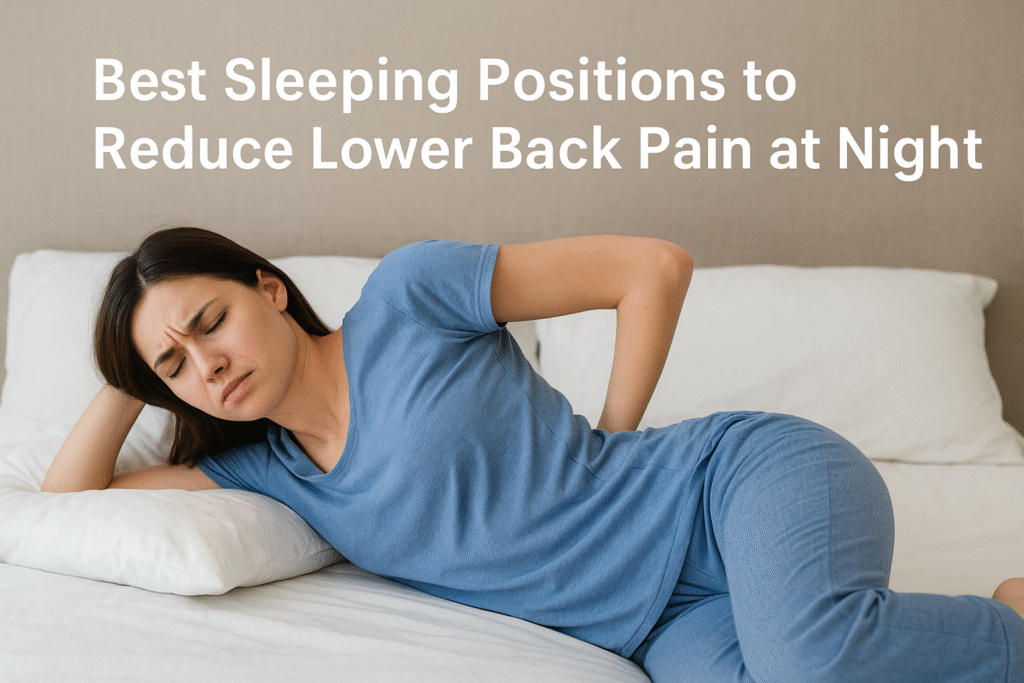Waking up with lower back pain at night can be frustrating especially when you expect rest to heal your body, not hurt it. The way you sleep plays a critical role in your spinal alignment and overall spine health. Choosing the best sleeping position for back pain isn’t just about comfort it’s about reducing pressure on the lower back, supporting the spine’s natural curve, and allowing muscles to relax and recover.
Understanding the right sleeping position is important, but if you’re unsure why back pain starts when you lie down, you can explore the main causes and relief methods.
In this article, we’ll explore the most effective sleeping positions to relieve lower back pain, along with expert tips on pillow placement and mattress support for a healthier, pain-free night’s sleep.
Why Sleeping Position Matters for Back Pain
Your sleep posture directly impacts how your spine aligns during the night. When your spine is out of alignment due to an awkward position or unsupportive mattress your lumbar region (lower back) bears unnecessary strain. This pressure can lead to stiffness, muscle tension, and back pain when lying down.
Poor posture during sleep also affects circulation and nerve health, which may worsen pain from conditions such as sciatica, herniated discs, or arthritis.
By learning the right sleeping position, you can distribute your body weight evenly, minimize stress on the lower back, and improve sleep quality.
Side Sleeping: The Best Position for Most People
Most experts, including chiropractors and sleep specialists, recommend side sleeping as the best position for people with lower back pain.
When you sleep on your side with a pillow between your knees, your hips, pelvis, and spine stay properly aligned, reducing tension in the lower back.
How to do it correctly:
- Lie on your side with your knees slightly bent.
- Place a firm pillow between your knees to keep your hips level.
- Use a supportive pillow under your head so your neck stays in line with your spine.
- Avoid curling into a tight fetal position, as it may restrict breathing and create neck strain.
Bonus tip: Try alternating sides each night to avoid developing muscle imbalance or shoulder pressure.
Sleeping on Your Back – Neutral Spine Support
If you prefer lying on your back, you can still relieve back pain — with the right adjustments. Back sleeping maintains the neutral spine curve, but only if your lower back isn’t arched too much.
How to do it:
- Place a pillow under your knees to reduce pressure on the lumbar spine.
- Consider a small rolled towel or lumbar pillow under your lower back for extra support.
- Use a medium-loft pillow under your head to keep your neck neutral.
This position can be ideal for people with degenerative disc disease or postural back pain, as it evenly distributes body weight and minimizes twisting.
Avoid Sleeping on Your Stomach
Sleeping on your stomach is the worst position for spinal alignment, as it forces your lower back into an unnatural curve and twists your neck. Over time, this can lead to chronic lumbar strain, neck stiffness, and nerve compression.
If it’s difficult to change your habit, try this transition tip:
- Place a thin pillow under your abdomen and pelvis to reduce spinal pressure.
- Use a flat pillow or none under your head to prevent neck overextension.
Still, working toward side or back sleeping is better for long-term spinal health.
Optimize Your Mattress and Pillow Setup
Even the best sleeping position won’t help if your mattress and pillows aren’t supportive. The right bedding setup maintains your spine’s natural curvature and reduces stress on pressure points.
Mattress Recommendations:
- Choose a medium-firm mattress — studies show it’s most effective for reducing chronic lower back pain.
- Replace mattresses older than 7–10 years.
- Consider memory foam or hybrid mattresses for balanced support and comfort.
Pillow Tips:
- Your pillow height should align your neck with your spine (not too high or low).
- Use a knee pillow or body pillow for side sleeping.
- Try lumbar cushions for back sleeping if you have a gap under your lower spine.
Add Gentle Stretching Before Bed
Simple bedtime stretches can relax your back muscles, improve flexibility, and enhance spinal alignment before you sleep. Focus on gentle yoga poses like:
- Child’s Pose (Balasana)
- Knee-to-Chest Stretch
- Cat-Cow Pose
- Pelvic Tilt
These stretches promote circulation and help your body ease into restorative sleep.
When to Consult a Professional
If your back pain at night persists despite adjusting your sleeping position and mattress, consult a doctor, physical therapist, or chiropractor. Chronic pain may signal disc issues, arthritis, or nerve compression that requires professional treatment.
A healthcare expert can assess your spinal alignment and recommend customized posture correction, physical therapy, or ergonomic advice.
Final Thoughts
Choosing the best sleeping position for lower back pain can transform how you feel every morning. The goal is simple: maintain spinal neutrality, use the right mattress and pillow support, and give your body time to heal naturally during rest.
By optimizing how you sleep not just how long you sleep you can reduce nighttime back pain, improve mobility, and enjoy deeper, more restorative rest.


